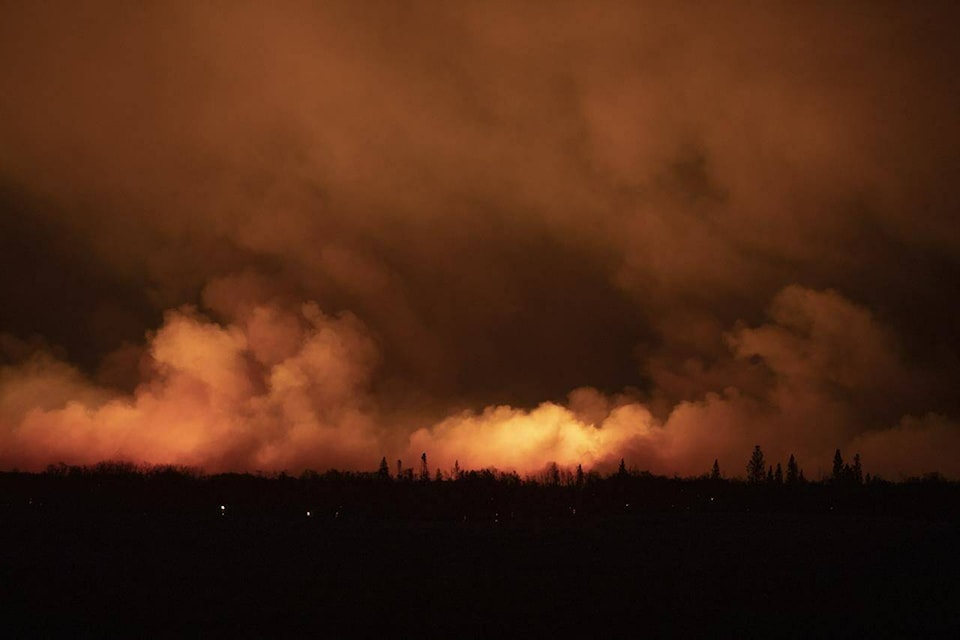A rainy Thursday in and around Fort Nelson was exactly what fire crews were looking for.
In a video released late Thursday night by the B.C. Wildfire Service, fire behaviour specialist for the Parker Lake and Patry Creek blazes Evan Peck said recent rain was much needed and made for excellent conditions for fire suppression crews.
While more rain is forecast in the coming days, Peck says there’s not been nearly enough precipitation yet to overcome long-term drought conditions in northeast British Columbia.
Crews continue to battle the Parker Lake and Patry Creek blazes, both of which are threatening Fort Nelson and are classified as out of control.
To date, the Parker Lake wildfire burning two kilometres west of town has forced thousands to evacuate and is holding steady at 123 square kilometres in size.
The Patry Creek wildfire is much larger, with the latest data from the B.C. Wildfire Service Friday morning indicating that the fire burning 25 kilometres north of Fort Nelson had swelled to 718 square kilometres.
One of the largest wildfires burning in Western Canada, Patry Creek re-emerged May 2 after smouldering through the winter.
Patry Creek is a so-called holdover fire, and wildfire officials in British Columbia have expressed concern that last year’s record fire season, along with continued drought conditions, will mean more such fires remain a threat.
Here’s a closer look at what holdover fires are and their threat to Western Canada.
—-
WHAT ARE HOLDOVER FIRES?
The BC Wildfire Service defines a holdover as “a fire that remains dormant and undetected for a considerable time after it starts.”
The service said in a blog post in February that such blazes are especially common with lightning-caused fires, large-scale wildfires or those happening with dry fuels seven centimetres or deeper underground.
When the conditions are right, fires burning deep underground can “slumber” undetected, simmering even under snow for possibly months after ignition.
These fires can then emerge when the weather warms and dries in the spring, as was the case with Patry Creek, which overlaps with a wildfire area that initially ignited by lightning in July 2023.
“It seems like it shouldn’t happen, but we have had really long sustained periods of serious drought in British Columbia and particularly in the northeast part of the province,” said BC Wildfire Service Information Officer Sarah Budd.
“Some of the fires that were burning during the 2023 season, which were significant in size … continue to burn, but they continue to burn underground. So they start to smolder and you can actually have snow and precipitation fall on top of those fires and they’ll continue to exist underground.”
IS THIS A NEW PHENOMENON?
“It’s certainly something that, as an agency, we have dealt with holdover fires for my entire career for 21 years,” said BC Wildfire Service director of operations Cliff Chapman. “This is not a new situation for British Columbia.”
Holdover fires are also not unique to British Columbia. Chapman said firefighters in Alberta and Manitoba have also seen such fires this year.
What has changed, Chapman said, was the more than 28,000 square kilometres of land that burned in B.C. last year, which when combined with drought conditions has “amplified” the risk stemming from such wildfires.
In January, more than 100 wildfires were still listed as burning in B.C., many more than the typical few dozen holdovers year to year, according to BC Wildfire Service spokesman Forrest Tower.
Of the 130 active wildfires burning across the province on Tuesday, 85 were holdovers from the 2023 fire season, Budd said.
The B.C. River Forecast Centre says persistent drought conditions in B.C. stretch back to 2022 and the province is heading into this summer with “multi-year” precipitation deficits, with the average snowpack level lower than ever recorded.
WHY CAN’T THEY BE PUT OUT IN WINTER?
Chapman said the wildfire service does plan for holdovers, and concern of their emergence this spring was one reason why teams were already in Fort Nelson before attention turned to the Parker Lake blaze, which now threatens the community and forced 4,700 people from their homes.
Detection of holdover fires is a major challenge because of how deep they can burn, Chapman said.
“It is important to note that just because the fires were underground, there was still snow on top of these fires,” he said. “They were not producing heat signatures for a big portion of the winter.
“We had very limited heat signatures until it started to become snow-free.”
Tower said the depth of the holdover fires present another challenge, even when they are found.
“It’s just how deep some of these fires burned and the size of them,” he said in January. “It takes a ton of manual labour to dig deep enough or to access some of these more remote fires.”
HOW CAN THE THREAT BE REDUCED?
Chapman said the Fort Nelson wildfire experience is likely something that the wildfire service will learn from in terms of anticipating the impact of future holdover fires.
He said the wildfire service will continue to work with land users and governments to understand where fires are simmering from year to year, in order to deal with future recurrences.
But the key may be to stop as many fires as possible from being started in the first place, Chapman said.
“The answer to a lot of these questions is really in prevention,” he said. “It’s really in FireSmart, it’s really in using the BC Wildfire Service initiatives, the ministry initiatives, trying to create a more resilient land base, which is a much broader question.”
READ ALSO: B.C. wildfire inflicts ‘some structural damage’ in Fort Nelson
READ ALSO: Canada may see more ‘zombie fires’ as climate warms and winters shorten



